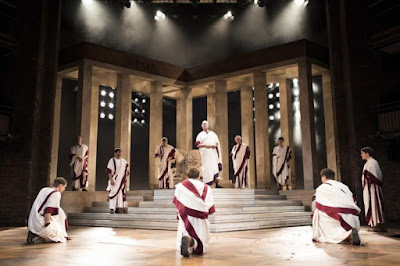James
Karas
After you have found
the singers, the orchestra and chorus, a successful production of an opera
requires a grand vision and scrupulous attention to details. The Metropolitan
Opera has assembled everything for its new production of Tosca and the result is,
not surprisingly a massive success despite numerous mishaps of which more
below.
Let’s start with the
singers. The title role is taken by Bulgarian soprano Sonya Yoncheva. She has a
luminous voice and manages to give a truly dramatic performance as the jealous
diva. She and her lover Cavaradossi (tenor Vittorio Grigolo) are youthful
lovers who cannot keep their hands and lips off each other. Their duets and her
solos are splendid examples of vocal delivery. Her “Vissi d’arte” may lack some
of the sustained high notes and emotional breadth we ideally expect but it
brought the house down. Her relish in killing Scarpia was delightful for those
of us who love to see a creep put down for ever.
Grigolo brought youth
and erotic intensity to Cavaradossi. His fine voice and physical agility make
him ideal for the role. He was especially dramatic and moving in his “E lucevan
le stelle” where the camera concentrated on his face poised from underneath.
Everything was right about his singing and he brought the house down.
Baritone Željko Lučić
sings the nasty Scarpia and he is splendid at it. Lučić has a resonant voice that
he uses to fine effect to express his evil megalomania and cruel depravity.
With the deep furrow between his eyebrows and his swaggering, authoritarian
manner, he expresses a man who is used to getting his way. A superb
performance.
The Metropolitan Opera
Chorus has an easy night with singing basically only a “Te Deum” but the
segment rises to absolutely thrilling heights. The Metropolitan Opera Orchestra
conducted by Emmanuel Villaume rises to equal heights throughout.
Tosca
has had a somewhat spotty history at the Met of late. After revving Franco
Zeffirelli’s production of the 1980’s for a quarter of a century, General
Director Peter Gelb hired Luc Bondy to do something different. It was a more or
less a disaster not that there were not people who thought highly of it. For
the current new production, Gelb retained Director David McVicar who has opted
for a traditional, opulent production in line with Franco Zeffirelli’s.
McVicar and Set and
Costume Designer John Macfarlane give traditional sets. The first scene set in
the Church of Sant’Andrea della Valle features grand pillars and an imposing
interior of a Baroque cathedral. Scarpia’s office is large, mostly dark with
the painting of The Rape of the Virgins and suggestive of menace. The ramparts
of Castel Sant’Angelo with the winged statute of the Archangel Michael hovering
above is another example of operatic sets on a grand scale.
But along with the
grand vision, McVicar pays attention to countless details that give the
production an unexpected freshness. A few examples. McVicar humanizes the
Sacristan (Patrick Carfizzi) be making him take snuff to calm his nerves and
slightly mocking Cavaradossi. We like the Sacristan.
When Cavaradossi tries
to kiss Tosca in the church, she pushes him away because they are in front of
the Madonna. Then she points to a spot where the Madonna cannot “see” them and
they smooch like the young lovers that they are. Tosca is burning with love,
Cavaradossi tells us, and he is right and she proves it.
A scene from Act III of David McVicar's new production of
"Tosca".
Photo: Ken Howard/Metropolitan Opera
As Scarpia is ordering
his henchmen to search for Angelotti in the church, several attractive women
walk by and one of them looks longingly at him. This lecher has many women on
the line. In his office with Tosca, he brags of his lust and of his preference
for violent sex. The word has almost gone from common usage, but Scarpia is a
rapist. When he tries to rape Tosca he grabs her breast and then her crotch.
This is the gross conduct of a rapist and McVicar does not shy from showing his
action graphically.
Cinema director Gary
Halvorson showed many scenes from below giving extraordinary details that the
audience at Lincoln Center did (could) not have witnessed. I have criticized
and almost shown contempt for many of his efforts in the past. This time I have
nothing but praise for him.
Few words about some of
the debacles that the production faced. Jonas Kaufman cast as Cavaradossi
bailed out and was replaced by Grigolo who has never sung the role before. Kristine
Opolais quit as Tosca. Hello, Sonya. Conductor Andris Nelsons dropped his baton
and James Levine was sent to pasture over allegations of sexual misconduct.
Welcome, Emmanuel Villaume. Baritone Bryn Terfel phoned in vocal fatigue – what
are you doing tonight Željko?
Despite all of those
mishaps, this proved to be a thrilling performance on the big screen in every
respect from vision to detail, to singing and to a grand afternoon at the
opera.
_____________
Tosca by Giacomo Puccini was shown Live in HD from the
Metropolitan Opera on January 27, 2018 at the at the Cineplex VIP Don Mills
Shops at Don Mills, 12 Marie Labatte Road, Toronto Ontario M3C 0H9 and other
theatres. Encores will be shown on February 17, 26, 28, March 3 and 11 2018 at
various theatres. For more information: www.cineplex.com/events






















